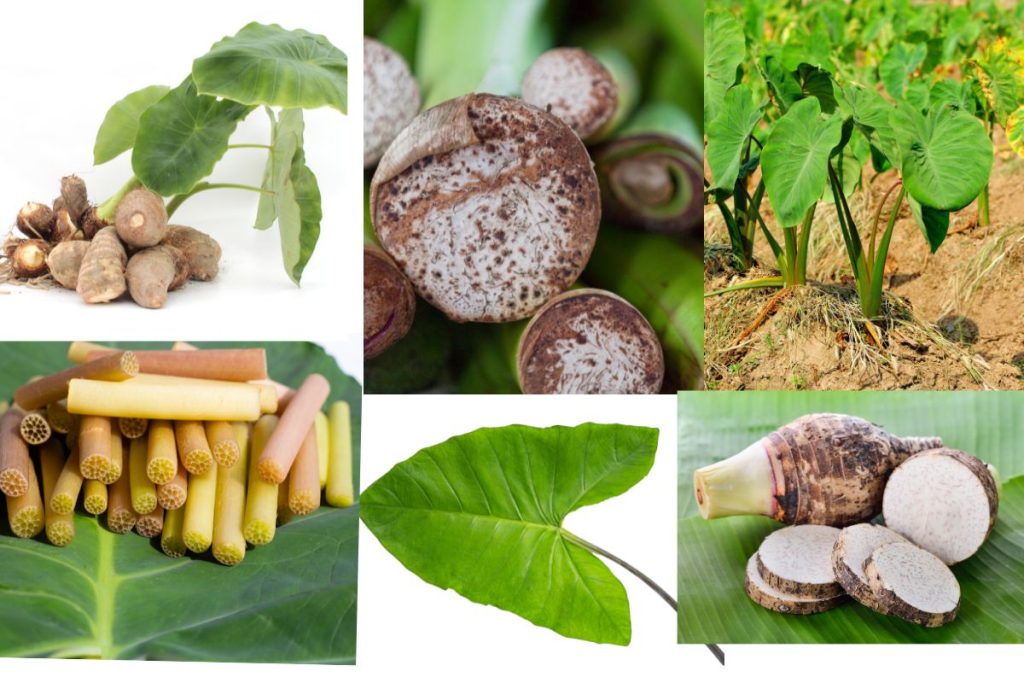Taro leaves are large heart-shaped leaves that are commonly used in cooking in many cultures, particularly in Southeast Asia, South Asia, and the Pacific Islands. They are also sometimes used for medicinal purposes.
Taro leaves are also believed to have various health benefits. They are a good source of vitamins A and C, as well as iron, calcium, and other minerals. Some studies suggest that they may have anti-inflammatory properties and may help to lower cholesterol levels.In this article we discuss about how to care and grow for taro leaf ………
Botanical Name -Colocasia esculenta.
Native – Southeast Asia and Southern India
Common Name-taro leaf, elephant ear, dasheen leaf
Health Benefits of Taro Leaf
Taro leaves have several potential health benefits. Here are some of them:
- Good source of vitamins and minerals: Taro leaves are a good source of vitamins A and C, as well as iron, calcium, and other minerals.
- Anti-inflammatory properties: Some studies suggest that taro leaves may have anti-inflammatory properties, which could help to reduce inflammation in the body.
- Lower cholesterol levels: Some research suggests that taro leaves may help to lower cholesterol levels in the blood, which could help to reduce the risk of heart disease.
- Boost immune system: Taro leaves contain high amounts of antioxidants that can help boost the immune system and protect the body from oxidative stress.
- Promote digestion: The fiber content in taro leaves can help promote digestion and prevent constipation.
Tips:-It’s worth noting that while taro leaves have several potential health benefits, they also contain calcium oxalate, which can cause irritation and discomfort in the mouth and throat if consumed raw. Therefore, taro leaves should always be cooked thoroughly before eating.
Care for Taro Leaf
Taro plants are relatively easy to grow and care for, here are some tips for growing and caring for taro leaves:
Climate:
Taro plants thrive in warm, tropical climates with high humidity. They can also grow in temperate climates as long as they are protected from frost.
Soil:
Taro plants prefer well-draining, nutrient-rich soil. Adding organic matter such as compost to the soil can help improve soil fertility.
Water:
Taro plants require consistently moist soil, so regular watering is essential. However, make sure the soil is not waterlogged, as this can cause the roots to rot.
Fertilizer:
Taro plants benefit from regular fertilization during the growing season. Use a balanced, all-purpose fertilizer every two weeks or so.
Sunlight:
Taro plants prefer partial shade to full sun. In hot climates, they may benefit from some afternoon shade to protect them from intense sun exposure.
Harvesting:
Taro leaves can be harvested when they are young and tender, usually when the plant is around six to eight months old. Simply cut the leaves off at the base of the stem, taking care not to damage the plant.
Pest and disease control:
Taro plants are relatively pest and disease resistant, but they can be affected by common garden pests such as aphids, mealybugs, and spider mites. Regular monitoring and insect control measures such as spraying with neem oil can help prevent pest infestations.
Edible parts of Taro Leaf

The Colocasia esculenta, commonly known as taro, is an edible plant that has several parts that are consumed in different ways. Here are the edible parts of the taro plant:
- Taro root: The most commonly consumed part of the taro plant is the underground corm, which is also known as the taro root. It has a starchy texture and can be boiled, steamed, roasted, or fried and used in a variety of dishes.
- Taro leaves: Taro leaves are also edible and are used in cooking in many cultures, particularly in Southeast Asia, South Asia, and the Pacific Islands. They can be boiled, steamed, or fried and used as a wrapper or filling for dishes, or cooked and eaten as a vegetable.
- Taro stems: The young stems of the taro plant are also edible and can be boiled or steamed and eaten like a vegetable.
- Taro shoots: The tender shoots of the taro plant are also edible and can be cooked and eaten like asparagus.
Propagation of taro leaf
Propagation of taro leaf can be done in a few different ways, including through stem cuttings, division of corms or rhizomes, and planting suckers or offsets. Here are some steps you can follow to propagate taro leaf:
- Select a healthy taro plant: Look for a healthy taro plant with strong leaves and stems. This will ensure that the new plant you propagate will also be healthy.
- Choose a propagation method: As mentioned earlier, there are several methods to propagate taro leaf. Choose the one that suits your needs.
- Propagation through stem cuttings: Cut a healthy stem from the taro plant using a sharp, clean knife or scissors. Make sure the cutting is at least 6 inches long and has a few leaves attached. Place the cutting in water or soil until roots form.
- Propagation through corms or rhizomes division: Dig up the taro plant carefully and separate the corms or rhizomes. Cut them into sections with at least one bud each. Plant them in soil with the bud facing up and cover with soil.
- Propagation through suckers or offsets: Look for small plantlets that have grown from the base of the taro plant. These are called suckers or offsets. Gently remove them from the mother plant and plant them in soil.
- Care for the new plants: Water the new plants regularly and provide them with enough sunlight. They will usually take a few weeks to establish themselves, so be patient.
Propagation of taro leaf can be a fun and rewarding way to expand your garden. With a little patience and care, you can easily propagate your own taro plants. Happy Gardening….







